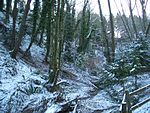Louisa Boren Park
Capitol Hill, SeattleKing County, Washington geography stubsParks in Seattle

Louisa Boren Park is a 7.2-acre (29,000 m2) park in Seattle, Washington. A heavily wooded hillside and lookout with views to the northeast of the city, Lake Washington, and the Eastside, it is located at the north end of the Capitol Hill area, adjacent to Interlaken Park, out of which it was created in 1913. It was named after Louisa Boren Denny, wife and sister of Seattle pioneers David Denny and Carson Boren, respectively. The Seattle Arts Commission commissioned artist Lee Kelly (b. 1932) to create an untitled sculpture for the park in 1975.
Excerpt from the Wikipedia article Louisa Boren Park (License: CC BY-SA 3.0, Authors, Images).Louisa Boren Park
East Garfield Street, Seattle Capitol Hill
Geographical coordinates (GPS) Address Nearby Places Show on map
Geographical coordinates (GPS)
| Latitude | Longitude |
|---|---|
| N 47.634368 ° | E -122.31237 ° |
Address
Untitled Cor-Ten Steel Sculpture
East Garfield Street
98102 Seattle, Capitol Hill
Washington, United States
Open on Google Maps









